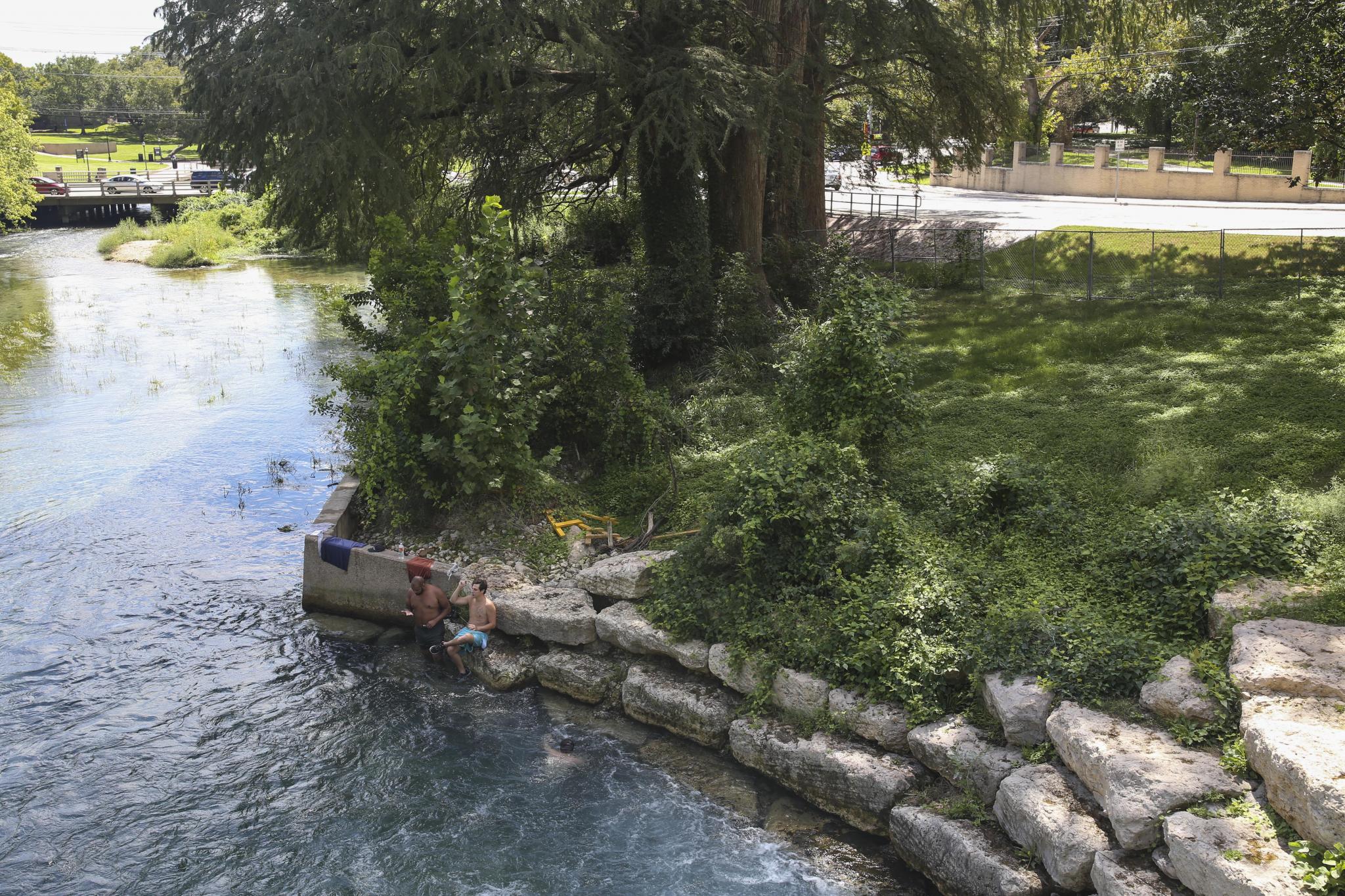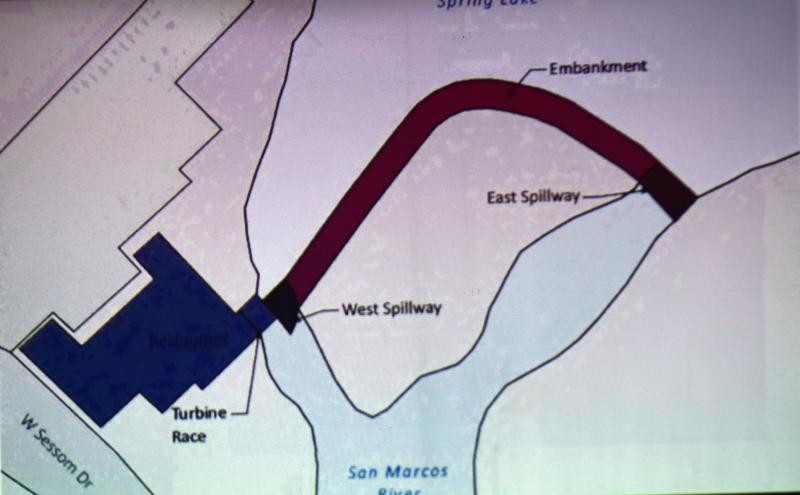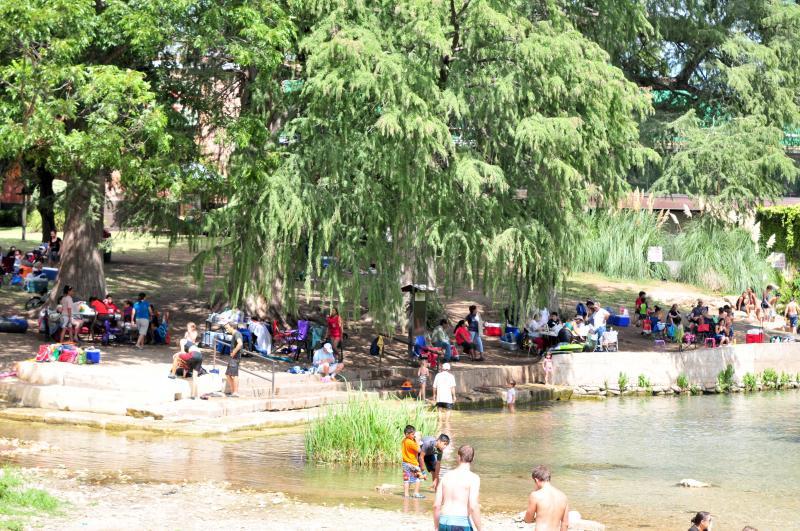
Although the area below the dam is fenced off, people can still access the the swimming hole by swimming up the San Marcos River. Pieces of orange sawhorses still litter the site where the bank has been reinforced after it was damaged by the floods of 2015. Daily Record photo by Denise Cathey
Finally ... a dam plan!
After suffering extensive damage in floods from 2013 through 2015, Spring Lake Dam is due for repairs — and after three years, Texas State University is ready to put a construction company to work on the project.
Monday evening, Texas State University Vice President for Finance and Support Services Eric Algoe gave a presentation to the public on the university’s progress toward repairing the dam and opening up the adjacent swimming hole for recreation once more. The university owns the dam and has been working with the Federal Emergency Management Agency (FEMA), U.S. Army Corps of Engineers (USACE), U.S. Fish and Wildlife Service (USFWS) and other agencies to acquire support for the repairs and approval of a plan that will minimize harm to the endangered species that live near — and even inside — the structure.

A diagram of Spring Lake Dam.
Spring Lake Dam suffered damage during the 1998 flood and was repaired in 2001. Similarly, after enduring wear and tear from two other floods, the structure was damaged during the October 2015 flood, Algoe said, when waters did not subside for two to three days.
“The dam itself was under 6-8 feet of water for the better part of that period of time,” Algoe said. “... It was a week before the water got back down to the level where the dam was holding the water back again.”
Because the flood was declared a disaster event, FEMA offered assistance and is paying for 75 percent of the dam repair project. However, Algoe said, FEMA funding often comes with a very long timeline, and the federal agency’s attention was often directed elsewhere, such as Houston in the aftermath of Hurricane Harvey.
Texas State hired Freese and Nichols Inc., as an engineering firm in spring 2017 to begin planning the repair project. However, the university also had to submit a biological assessment to the USFWS and receive an opinion from the agency as to whether the plan would cause harm to the endangered species living in the areas around the dam and within the dam. Spring Lake Dam is porous, Algoe explained, noting that the dam has had only minor repairs since settler Edward Burleson had it built in 1849.
“It’s basically wood and earth,” he said.
That porosity means the dam is not likely to burst, but it also means that animals like the endangered fountain darter have taken up residence inside the structure itself. Moreover, Algoe said, the endangered Texas Wild Rice has re-established itself in the area between the dam and the Aquarena Springs Drive bridge, and the university wants to protect as much of that habitat as possible.
“This is kind of the last piece of the puzzle,” Algoe said of the USFWS opinion, which he said he received just about an hour before Monday’s presentation. He said he only had a chance to glance over the USFWS opinion but that it did not appear to call for any changes to Freese and Nichols’ plan.

Prior to the floods of 2015, the area was one of — if not the — premier swimming spot along the upper San Marcos River. Daily Record file photo
The repairs to the dam will involve recapping it and moving in “many, many, many metric tons of stone” to add more mass to the dam. Some water will still move through the structure, Algoe said, and it will not be made any taller than it already is. The repairs are meant to stabilize the structure and bring it up to standards, Algoe explained. The expected timeline is to send out requests for proposals to construction companies within a month, get started on the project later this year and have the dam repaired by next spring.
However, the dam is not the only issue in that part of the river. A portion of the river bank that once was open to recreation has been fenced off for three years. Algoe said that the fencing is not because, as some might assume, there is imminent danger from Spring Lake Dam.
“The real issue is there’s a significant sinkhole under this area,” he said. “You can see the sunken depression in the ground.”
The way the sinkhole has developed, Algoe said, it seems likely that the river will reclaim that part of the bank.
“It’s really quite dangerous to be in that area,” he said.
FEMA will not pay for the bank restoration the university hopes to perform, Algoe said, but Texas State is working on a plan to make the riverbank safe again and have it open for recreation by next summer.











